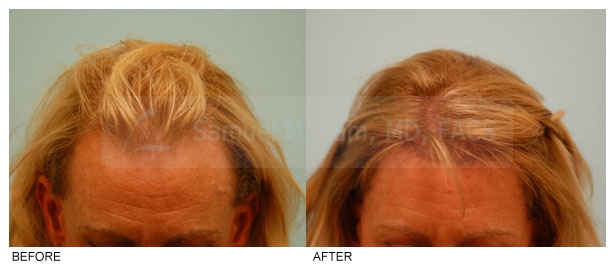-
Hair Loss in Women: What Can Be Done?
Sunday, April 21st, 2024by Samuel Lam, M.D.
I want to talk about a subject that is very important to me, and that is hair loss in women. In many ways, this is a subject that borders on taboo.
Most women, if they are experiencing hair loss, simply don’t want to talk about it. While losing one’s hair may be worrisome for a man, it can be much more traumatic for a woman.
One big reason is that women don’t have a peer support group to talk to about hair loss, and instead have to remain silent.
In my opinion, it’s important to be able to discuss the considerations and medical options available to women who are losing their hair.
There are a variety of surgical techniques for hair loss available, and I’d like to try and walk you through the whole process of hair restoration for women.
Let’s begin by dividing women who are experiencing hair loss into two groups:
- Women who lose hair pre-menopausally (before menopause).
- Women who lose hair post-menopausally (after menopause).
Women Who Lose Their Hair Before Menopause
There are a lot of conditions that may lead to hair loss in women pre-menopausally. Some of the more prevalent conditions out there that may cause hair loss in women include a low iron level due to iron loss at menstruation (and a corresponding lack of iron replacement through supplementation).
Other examples could be hormonal imbalances where androgen and testosterone levels are elevated. A simple blood test can determine this. Low thyroid levels can also lead to hair loss.
Other syndromic problems such as polycsystic ovarian disease with facial hair and other masculinizing attributes may be a cause of thinning hair.
Even psychological conditions like the hair-pulling disorder trichotillomania may be playing a part. Or other dermatologic conditions like alopecia areata, where you are losing little circles of hair, can be a cause of hair loss in women.
There are a variety of skin conditions in addition to hormonal and other imbalances that could be causing your hair to fall out.
In consultation with dermatologists and internists, I am able to do some basic blood evaluations that can show the reasons for hair loss in women.
Hair Loss in Women After Menopause
In the case of women who are past menopause, all of the above conditions can exist, but most of the time as the hormones become slightly imbalanced due to the aging process, it’s more common to have hair loss occur.
The important thing to understand is that there is hope. There are solutions to hair loss in women, and I want to talk about the options available.
The Internet is full of so-called “hair loss solutions,” but the truth is that there are a lot of gimmick products out there.
FDA-Approved Medications for Hair Loss in Women
There is really only one FDA-approved medication for women’s hair loss, which is called Rogaine or minoxidil (which is the generic).
Minoxidil or Rogaine is a product that is applied on the scalp itself to help regrow hair. It does take about six months to a year to work, and once you start using it, and then stop, you will see the hair start to fall back out again.
 Rogaine doesn’t necessarily regrow all the hair, but it can often times slow down the process of hair loss significantly.
Rogaine doesn’t necessarily regrow all the hair, but it can often times slow down the process of hair loss significantly.There are two concentrations of Minoxidil, 2% and 5%. The two percent is for women and the five percent for men.
But for women who are having significant hair loss and want to speed up the process, the 5% may be better.
The only risks are some possible side effects with 5% Rogaine like masculinizing hair growth, but if they occur, you can scale back to 2% to reverse them.
Rogaine should be used twice a day to combat hair loss, and should be considered an important non-surgical treatment for women who are experiencing hair loss.
Surgical Options for Women with Hair Loss
As far as surgical options, it all begins with understanding the donor area, which is the area toward the back of the head.
For a successful hair transplant, there has to be a stable area that is not losing significant numbers of hair.
There are basically 3 types of hair loss in women:
- Diffuse pattern hair loss, where the hairline is still strong, but there is a general thinning as you move back. There is a Ludwig scale that talks about the different degrees of hair loss, which is available on my Web site.
- Hairline loss and also thinning in the temporal area, plus diffuse pattern hair loss as you move toward the back. This can be a variant of male pattern baldness.
- A Christmas tree pattern, which Elise Olsen argues is the most common type. In this case, the hair loss tapers to a point at the crown of the head. The hairline can be spared or involved.
The way we do hair transplant in women in terms of donor harvesting is the same as we do for men. It’s basically a gentle process, where we use an intravenous sedation cocktail so that the patient doesn’t feel any pain.
Despite advances with so-called follicular-unit extraction (FUE) in which hairs are harvested one at a time from the back of the head, this technique really is not suitable for women since it is more expensive, involves shaving the head at the back, and is designed for men who want to wear a very short haircut.
Male vs. Female Hair Transplantation Techniques
The way we create the hairline and the temporal sweep is very different for a female.
The way I design and frame the face is completely different, if not opposite, for a woman than it is for a man.
I want to create a very strong temporal frame. I re-create all the angles of the temporal area to match exactly the sweep and shape of the female.
The female hairline is very different. It’s not just a straight hairline. There is often a bit of a widow’s peak. There is a lot of subtlety required to make sure that we replicate the way a woman’s hairline grows naturally.
Another thing that is different with my approach comes from the fact that often women are not satisfied with the density that is achievable with hair restoration.
As a result, I have developed a procedure called combination grafting. With this technique we are able to achieve significantly greater density into the central scalp where there is potentially diffuse hair loss.
During a consultation in our office, we can see what techniques are applicable to your particular situation. I look forward to helping you overcome your hair loss, either medically or with surgery.
(published June 5, 2013)
 Samuel M. Lam, M.D. is a double board-certified facial plastic surgeon and a board-certified hair transplant surgeon. The author of five major medical textbooks, Dr. Lam lectures monthly both nationally and internationally. He has also been distinguished as Surgeon-of-the-Month by the International Society of Hair Restoration Surgery, of which he is a member. Dr. Lam is the owner of the 27,000 square foot Willow Bend Wellness Center in Dallas, Texas, which supports meditation, revitalization, rejuvenation, relaxation and wellness. He can be reached at 972-312-8188.
Samuel M. Lam, M.D. is a double board-certified facial plastic surgeon and a board-certified hair transplant surgeon. The author of five major medical textbooks, Dr. Lam lectures monthly both nationally and internationally. He has also been distinguished as Surgeon-of-the-Month by the International Society of Hair Restoration Surgery, of which he is a member. Dr. Lam is the owner of the 27,000 square foot Willow Bend Wellness Center in Dallas, Texas, which supports meditation, revitalization, rejuvenation, relaxation and wellness. He can be reached at 972-312-8188.




